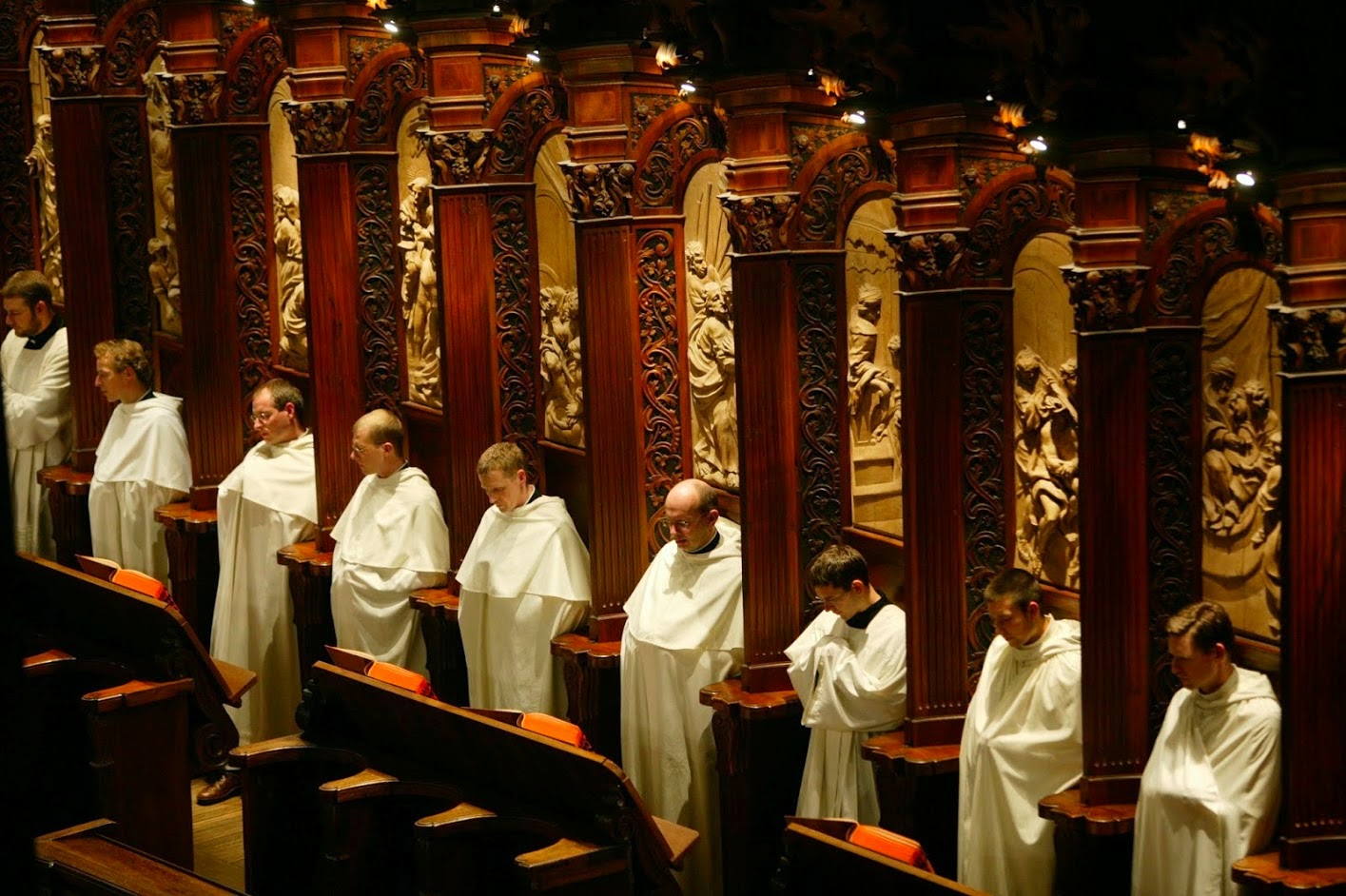Last May while visiting a dear friend, Pater Edmund Waldstein, O.Cist., a monk of the Abbey of Heiligenkreuz in Lower Austria and maintainer of the ever-thoughtful blog Sancrucensis, I had the opportunity to see certain parts of the monastery that I had never seen (or seen up close) before. Among the stages of our tour were the immensely beautiful wooden choir stalls where the monks chant the daily Divine Office, to which they are very devoted.
But it was not so much the woodwork that caught my attention as it was certain over-sized wood-covered leatherbound volumes set up between every other stall.
As a cantor and schola director, these naturally engaged my curiosity and I asked Pater Edmund to tell me about them. Seeing my great interest, he not only obliged me at the moment, but sent notes and photos to be shared with the readers of NLM who might be interested in this fine example of contemporary book-making on a scale rarely seen. What follows is Pater Edmund’s account of the genesis of this project.
![]()
But it was not so much the woodwork that caught my attention as it was certain over-sized wood-covered leatherbound volumes set up between every other stall.
As a cantor and schola director, these naturally engaged my curiosity and I asked Pater Edmund to tell me about them. Seeing my great interest, he not only obliged me at the moment, but sent notes and photos to be shared with the readers of NLM who might be interested in this fine example of contemporary book-making on a scale rarely seen. What follows is Pater Edmund’s account of the genesis of this project.
Heiligenkreuz Choir Books
Pater Edmund Waldstein, O.Cist.
In the 1970s Heiligenkreuz put together an edition of the Divine Office that was meant to adopt some of the reforms of the new Roman Office, while preserving many traditional monastic elements. It was decided to adopt a two-week Psalter developed by Fr. Guido Gilbert-Tarruel, O.Cist., which sought to preserve many features of the division of the Psalms given by St. Benedict in the Rule. (Fr. Gilbert-Tarruel’s division, included in the latest edition of the Cistercian Ritual as one among many options for Cistercian monasteries, is reproduced below.) At the time, it was hoped that other Cistercian monasteries would adopt our breviary, but today Heiligenkreuz is the only monastery that uses it, as well as the only monastery that uses this particular Psalm-division. It could be said, therefore, to constitute a sort of local usage, the “Heiligenkreuz Office.”
In the 1970s, hand-size editions of the breviary, hymnarium, antiphonarium, and psalter were printed. Inevitably, the wear and tear on the books, together with the desire for something more permanent and more worthy of the splendor of the liturgy, motivated the monastery to take a decisive step. In the early years of the millennium, work began on the large choir edition of the Psalter. For the new edition, everything was newly typeset by one of the monks, including all the music (this took him several years).
The choir Psalter is printed on thick Italian paper, usually used for reproducing art prints (size: DIN A3). It was bound by the monks in our own book-binding shop. The covers are made of wood harvested from the abbey’s own forests in the vicinity. The tabs are made of goat leather, and were cut and printed by one of the monks. The pictures are reproductions of pencil drawings by Michael Fuchs, drawn especially for this Psalter.
The monks have been using these magnificent books for close to ten years. The books are durable, easy to read, and beautiful. One may hope someday for a widespread revival of the art of the book, which, despite or perhaps because of its extremely ancient techniques, has much to recommend it in our high-tech world. As a Navajo Indian says to the elderly Bishop Latour in Death Comes for the Archbishop:“Men travel faster now, but I do not know if they go to better things.”
In the 1970s, hand-size editions of the breviary, hymnarium, antiphonarium, and psalter were printed. Inevitably, the wear and tear on the books, together with the desire for something more permanent and more worthy of the splendor of the liturgy, motivated the monastery to take a decisive step. In the early years of the millennium, work began on the large choir edition of the Psalter. For the new edition, everything was newly typeset by one of the monks, including all the music (this took him several years).
The choir Psalter is printed on thick Italian paper, usually used for reproducing art prints (size: DIN A3). It was bound by the monks in our own book-binding shop. The covers are made of wood harvested from the abbey’s own forests in the vicinity. The tabs are made of goat leather, and were cut and printed by one of the monks. The pictures are reproductions of pencil drawings by Michael Fuchs, drawn especially for this Psalter.
The monks have been using these magnificent books for close to ten years. The books are durable, easy to read, and beautiful. One may hope someday for a widespread revival of the art of the book, which, despite or perhaps because of its extremely ancient techniques, has much to recommend it in our high-tech world. As a Navajo Indian says to the elderly Bishop Latour in Death Comes for the Archbishop:“Men travel faster now, but I do not know if they go to better things.”


